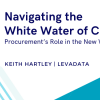Measuring the value of an outsourcing company for your own service requirements can be a surprisingly disorienting task to complete. But beyond its complexity, it also involves a lot of responsibility. Your decision is likely to affect your organisation’s strength and efficiency for the upcoming months, if not years. Making a good choice will mean the right level of support that will help your organisation grow. But selecting a wrong partner can be highly detrimental to the health of your business.
The right company to use depends on a large number of criteria that are typically assessed through a Request for Information (RFI). Once every outsourcing company returns their responses to your RFI, it is important to thin out the selection to only those with whom you would, potentially, be interested in working. Then, it’s comparison time. This is where the difficulties begin. How do you make a reliable comparison to ensure nothing is missed?
Without doubt, the assessment of potential nearshoring or outsourcing suppliers is a process best conducted as carefully as possible to minimise the risk of a failure for your business. Topic areas such as the infrastructure, experience and location (to name a few) of each of your potential partners all need to be deliberated over and assessed with almost equal measure.
When comparing a number of suppliers, it is best to work with a checklist which contains all criteria that matter to your organisation (see below for examples of areas you might want to consider). Based on responses to RFI, each supplier would then be awarded points on a numeric rating system (e.g. where 1 means ‘does not meet the requirement’ and 10 ‘fully meets the requirement’). This will keep your assessment reliable, consistent, and most importantly, it is the easiest way to navigate potential partners. This number-based comparison/checklist system is best actualised by using spreadsheets.
Through this spreadsheet technique, the user should map out a range of criteria to assess when comparing IT suppliers. Some of these include:
1. Overall company:
This topic should cover the company’s length of time in operation, legal and regulatory compliance, their financial stability and reputation. Consider their organisational culture – are they a good fit for you? Are they able to deliver the skills you need? Beyond thinking about your current needs, try to fast forward into the future and establish what skills or services you may need in a couple years’ time – would they be able to deliver them?
2. People:
It is the people, not the company as such, who will work with you on a day-to-day basis, so it is worth getting to know them as much as possible at this stage. The attitude an employee has towards their employer is very important as a frustrated employee may in practice mean a demotivated member of your outsourced team. Look into staff attrition rates, employee benefits and personnel retention activities. You may also want to check employee engagement in company life on the company blog and on social media.
3. The Company’s Capabilities:
This area covers the company’s technical skills, including whether it can or cannot operate across a variety of platforms, technologies and languages. This may include project management, business analysis, requirements gathering, process expertise, language skills and domain knowledge. It is also worth considering the methodologies and frameworks used by each company.
4. Experience and Reliability:
This is where you assess whether the experience of the outsourcing company is in line with your needs. Look for examples of previous successes where the technology has been implemented, the company demonstrated technical skills, repeatable delivery and proven methods and tools. In addition to case studies available on the suppliers’ websites and the information provided in the responses to RFIs, it might also be a good idea to call their previous or current clients.
5. Infrastructure:
Here, the size, quality, and modernity of the premises are analysed. Assessed factors will include the availability of space (such as meetings rooms and parking facilities), modern equipment, and perhaps most importantly, the infrastructure’s stability. It is also worth investigating whether the buildings belong to the outsourcing company – as this is more stable in terms of work continuity than rented properties.
6. Communication:
Effective communication is essential to the success of any project. This is all the more important when distance between two companies comes into play. As such, an outsourcing comparison spreadsheet should consider things which support communication, such as knowledge of common language, cultural proximity, overlaps in working hours and standard communication channels (e.g. Skype, teleconferencing or video calling), preferably those used at your company.
7. Commercials:
Questions you should consider in the ‘commercials’ category include: Is the supplier’s commercial model relevant to the needs of my organisation? What IP and copyright policies do they have on board? Are their processes streamlined for the ease of doing business? Would the cooperation be cost efficient?
8. Location:
When thinking about locations of your shortlisted IT outsourcing service providers, consider the geopolitical and economic stability of the countries and how easy it would be for you to visit them (and vice-versa). The country’s ranking in terms of outsourcing, its level of education, labour costs, and whether the company is covered by wider legalisation, standards and laws (such as the European legislation) should all be compared, as each can have a potentially huge impact on the outsourcing services provided to you.
9. Risk Management:
This category involves an assessment of each outsourcing company’s business continuity policies, and (perhaps more importantly) the mechanisms in place that both prevent and amend disasters. Other factors to address include audit controls, the security of data, equipment and buildings and the transparency of the company.
10. Any Additional Considerations:
While this list may seem extensive already, there are always final elements to take into account before a final decision on the outsourcing company for you can be made. Would a pilot project be possible? What extra benefits and services are on offer? Even questions such as ‘Can I trust them?’ and ‘Will I learn anything from them?’ are important to ask yourself.
Selecting an IT partner for your business is a serious, long-term decision with a lot of complex information that needs to be collated and analysed. In order to confidently select your perfect technology partner, an ideal IT supplier comparison tool should first and foremost be transparent and user friendly. The reader should undoubtedly be able to scan through the checklist quickly and without great effort. But if the information is both categorised and compared according to numerical values, and allows for reporting, then your boss and your colleagues (the people who will also be making the big decision) should have no trouble making their mind up either. Beyond supporting your decision, such a tool can be later integrated into your standard supplier selection process. But most importantly, it will help you make the whole process a little less daunting.






